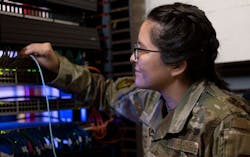Air Force asks industry for advanced cyber security prototypes for electronic warfare (EW) and SIGINT
ROME, N.Y. – U.S. Air Force cyber security experts are asking industry to develop next-generation cyber security prototypes for existing military aircraft and spacecraft; intelligence and reconnaissance; global strike; and command and control systems.
Officials of the Air Force Research Laboratory Information Directorate in Rome, N.Y., have issued an advanced research announcement for the Advanced Cyber Operations Prototypes (A-COP) project.
A-COP seeks to develop enabling technologies for an assured and trusted cyber infrastructure; for continually accessing command and control; for providing continuous situational awareness; for delivering effects-based defenses; for offering situational understanding; and for enhancing signals intelligence (SIGINT), electronic warfare (EW), and cyber operations.
Assured and trusted cyber infrastructure begins with proven-correct designs that are technologically immune to threats and have an autonomous ability to modify the cyber domain to avoid unforeseen attacks and emerging threats.
Related: Electronic warfare on the ground
Continually access and exercise command and control applies to cyber assets supporting on-demand missions. Continuous situational awareness seeks to avoid most threats and attacks. Effects-based defenses means using the assured and trusted infrastructure to compute, provision, and deliver effects-based defenses automatically.
Situational understanding seeks to establish a dependency map of mission functions and threads to infrastructure. SIGINT, EW, and cyber operations technologies include involves operational and contingency planning.
A-COP areas of interest include cloud architectures; code analysis and evaluation; cyber modeling and simulation; decision support for cyber missions; design frameworks; evaluation and measurement techniques; mobile and embedded device security; non-traditional cyber security in untrusted environments; protocol development and analysis; cyber situational awareness and risk estimation; secure development tools and techniques; standards for information exchange; trusted hardware and software; virtualization; and zero-trust computing.
Military systems of interest to the Air Force include embedded devices and firmware; mobile and bring-your-own devices; automation systems; tactical systems; and wired and wireless networks at the enterprise and tactical levels.
Related: Electronic warfare technology heading-up the battlefield
Air Force experts say they expect to spend nearly half a billion dollars on the A-COP project through 2028, and involve several different contractors. Deadlines for A-COP submissions are 1 Oct. 2024; 1 Oct. 2025; 1 Oct. 2026; and 1 Oct. 2027. This solicitation is open until 30 Dec. 2028.
Companies interested should email white papers to the Air Force's Thomas Parisi at [email protected]. Companies submitting promising white papers will be invited to submit full proposals.
Email business and contracting questions to Amber Buckley at [email protected]. More information is online at https://sam.gov/opp/a33858f292154a5094b4f25012f4cdcf/view.
About the Author
John Keller
Editor-in-Chief
John Keller is the Editor-in-Chief, Military & Aerospace Electronics Magazine--provides extensive coverage and analysis of enabling electronics and optoelectronic technologies in military, space and commercial aviation applications. John has been a member of the Military & Aerospace Electronics staff since 1989 and chief editor since 1995.
